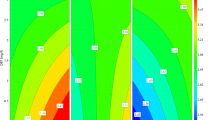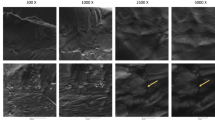Abstract
Purpose
Sol fraction, a measure of the free polymers removed from a ground tyre rubber (GTR) by organic solvent, and crosslink density, a measure of the number of sulphur crosslinks in the GTR, are necessary to determine whether a microbial activity causes both devulcanization and carbon degradation. The suitability of two sol fraction measurement methods to assessing the devulcanisation performance of At. ferrooxidans and a sulphur-oxidising consortium on industrial GTR was investigated.
Method
The devulcanisation performance and the relation between two Sol fraction methods (American Standard Testing Method, ASTM D6814 and the altered method) were determined for Acidithiobacillus ferrooxidans (DSMZ 14,882) and a mesophilic, sulphur-oxidising acidophilic consortium (UCT-30), used to treat unleached ground tyre rubber (untreated GTR) for 30 days.
Results
Both cultures were able to devulcanise untreated GTR after 30 days of incubation, despite the negative impact of the untreated GTR toxins on growth performance. The sulphur-oxidising consortium displayed the greatest toxin resistance and attached cells were observed at the surface of the untreated GTR particles. At. ferrooxidans (DSMZ 14,882) increased the Sol fraction of the GTR by 1.09 ± 0.9% (0.46 ± 0.1% ASTM) without causing any polymer degradation, whereas the sulphur-oxidising consortium increased the sol fraction by 0.56 ± 0.82% (− 0.26 ± 0.1% ASTM), but also caused polymer degradation at the surface of the GTR particles due to the activity of the heterotrophic microorganisms. In the comparison of the Sol fraction methods, ASTM yielded smaller absolute values, but better precision than the altered method. The absolute values for ASTM method fell within the range for the altered method due to the latter’s large variance. In addition, the ASTM method produced a change in sol fraction (Δsol) that was more consistent across the unleached GTR tested than the altered method
Conclusion
The ASTM sol fraction method provides better precision than the altered sol fraction method, making it more likely to indicate a statistically significant difference, despite the small absolute values measured. The altered method’s more aggressive treatment leads to larger observed changes in the sol fraction, making it easier to identify qualitative changes in the GTR properties. However, the higher temperature method also introduces increased variability leading to poor statistical significance of the results. Therefore, the results should not be reported without a quantification of the error.
Graphic Abstract







Similar content being viewed by others
References
Sienkiewicz, M., Kucinska-lipka, J., Janik, H., Balas, A.: Progress in used tyres management in the European Union : A review. Waste Manag. 32, 1742–1751 (2012). https://doi.org/10.1016/j.wasman.2012.05.010
Selbes, M., Yilmaz, O., Khan, A.A., Karanfil, T.: Leaching of DOC, DN, and inorganic constituents from scrap tires. Chemosphere 139, 617–623 (2015). https://doi.org/10.1016/j.chemosphere.2015.01.042
Christiansson, M., Stenberg, B., Holst, O.: Toxic additives - A problem for microbial waste rubber desulphuriation. Resour. Environ. Biotechnol. 3, 11–21 (2000)
Isayev, A.I.: Recycling of Rubbers. In: Mark, J.E., Erman, B., Eirich, F.R. (eds.) The Science and Technology of Rubber, pp. 697–764. Academic Press, San Diego (2005)
Mark, J.E., Erman, B., Eirich, F. (eds.): Science and Technology of Rubber. Academic Press, San Diego (2005)
Holst, O., Stenberg, B., Christiansson, M.: Biotechnological possibilities for waste tyre-rubber treatment. Biodegradation 9, 301–310 (1998)
Christiansson, M., Stenberg, B., Wallenberg, L.R., Holst, O.: Reduction of surface sulphur upon microbial devulcanization of rubber materials. Biotechnol. Lett. 20, 637–642 (1998). https://doi.org/10.1023/A:1005306220566
Romine, R., Romine, M.F.: Rubbercycle: a bioprocess for surface modification of waste tyre rubber. Polym. Degrad. Stab. 59, 353–358 (1998)
Adhikari, B., Maiti, S.: Reclamation and recycling of waste rubber. Prog. Poylmer Sci. 25, 909–948 (2000)
Stevenson, K., Stallwood, B., Hart, A.G.: Tire Rubber Recycling and Bioremediation: A Review. Bioremediat. J. 12, 1–11 (2008). https://doi.org/10.1080/10889860701866263
Jiang, G., Zhao, S., Luo, J., Wang, Y., Yu, W., Zhang, C.: Microbial Desulfurization for NR Ground Rubber by Thiobacillus ferrooxidans. J. Appl. Polym. Sci. 116, 2768–2774 (2010). https://doi.org/10.1002/app
Raghavan, D., Guay, R., Torma, A.E.: A study of biodegradation of polyethylene and biodesulfurization of rubber - Scientific note. Appl. Biochem. Biotechnol. 24–25, 387–396 (1990). https://doi.org/10.1007/BF02920262
Löffler, M.: Modifizierung von Altgummimehl durch mikrobielle Oberflächenentschwefelung - Ein Beitrag zum stofflichen Recycling von Altgummi, (1998)
Li, Y., Zhao, S., Wang, Y.: Microbial desulfurization of ground tire rubber by Thiobacillus ferrooxidans. Polym. Degrad. Stab. 96, 1662–1668 (2011). https://doi.org/10.1016/j.polymdegradstab.2011.06.011
Li, Y., Zhao, S., Zhang, L., Wang, Y., Yu, W.: The effect of different Fe2+ concentrations in culture media on the recycling of ground tyre rubber by Acidithiobacillus Ferrooxidans YT-1. Annu. Rev. Microbiol. 63, 315–321 (2013)
Li, Y., Zhao, S., Wang, Y.: Microbial desulfurization of Ground Tire Rubber by Sphingomonas sp.: A Novel Technology for Crumb Rubber Composites. J. Polym. Environ. 20, 372–380 (2012)
Hu, M., Zhao, S., Li, C., Wang, B., Yao, C., Wang, Y.: The influence of different Tween surfactants on biodesulfurization of ground tire rubber by Sphingomonas sp. Polym. Degrad. Stab. 107, 91–97 (2014). https://doi.org/10.1016/j.polymdegradstab.2014.04.025
Jiang, G., Zhao, S., Li, W., Luo, J., Wang, Y., Zhou, Q., Zhang, C.: Microbial desulfurization of SBR ground rubber by Sphingomonas sp. and its utilisation as filler in NR compounds. Polym. Adv. Technol. 22, 2344–2351 (2011)
Cui, X., Zhao, S., Wang, B.: Microbial desulfurization for ground tire rubber by mixed consortium-Sphingomonas sp. and Gordonia sp. Polym. Degrad. Stab. 128, 165–171 (2016). https://doi.org/10.1016/j.polymdegradstab.2016.03.011
Hu, M., Zhao, S., Li, C., Wang, B., Fu, Y., Wang, Y.: Biodesulfurization of vulcanized rubber by enzymes induced from Gordonia amicalisa. Polym. Degrad. Stab. 128, 8–14 (2016). https://doi.org/10.1016/j.polymdegradstab.2016.02.017
Bredberg, K., Persson, J., Christiansson, M., Stenberg, B., Holst, O.: Anaerobic desulfurization of ground rubber with the thermophilic archaeon Pyrococcus furiosus - A new method for rubber recycling. Appl. Microbiol. Biotechnol. 55, 43–48 (2001). https://doi.org/10.1007/s002530000499
Turton, R., Shaeiwitz, J.A., Bhattacharyya, D., Whiting, W.B.: Analysis, Synthesis, and Design of Chemical Processes. Prentice-Hall Inc., New York (2018)
Johnson, B.D., Hallberg, K.B.: Carbon, iron and sulfur metabolism in acidophilic micro-organisms. Adv. Microb. Physiol. 54, 201–255 (2009). https://doi.org/10.1016/S0065-2911(08)00003-9
ASTM. D297–13 StandardTest Methods for Rubber Products — Chemical Analysis. West Conshohocken: ASTM International; 2013.
ASTM. D6814–02 (2008) Standard Test Method for Determination of Percent Devulcanization of Crumb Rubber Based on Crosslink Density. West Conshohocken: ASTM International; 2011.
Edwards, D.W.: Comparison of the Technical and Economic Feasibility of Devulcanisation Processes for Recycling Waste Tyres in South Africa [Master’s Thesis]. Stellenbosch University, Stellenbosch, South Africa (2016)
Horikx, M.M.: Chain scissions in a polymer network. J. Polym. Sci. 19, 445–454 (1956). https://doi.org/10.1002/pol.1956.120199305
Edwards, D.W., Danon, B., Van Der, Gryp P.: Quantifying and comparing the selectivity for crosslink scission in mechanical and mechanochemical devulcanization processes. J. Appl. Polym. Sci. 43932, 1–10 (2016)
Li, Y., Zhao, S., Wang, Y.: Improvement of the properties of natural rubber/ground tire rubber composites through biological desulfurization of GTR. J. Polym. Res. 19, 9864 (2012). https://doi.org/10.1007/s10965-012-9864-y
Kaewpetsch, B., Prasongsuk, S., Poompradup, S.: Devulcanization of natural rubber vulcanizates by Bacillus cereus TISTR 2651. Express Polymer Lett 13(10), 877–888 (2019)
Tatangelo, V., Mangili, I., Caracino, P., Anzano, M., Najmi, Z., Bestetti, G., Collina, E., Franzetti, A., Lasagni, M.: Biological devulcanization of ground natural rubber by Gordonia desulfuricans DSM 4462 strain. Appl. Microbial Biotechnol. 100(20), 8931–8942 (2016)
Tatengelo, V., Mangili, I., Caracino, P., Bestetti, G., Collina, E., Anzano, M., Branduardi, P., Posteri, R., Porro, D., Lasagni, M., Franzetti, A.: Microbial desulfurization of ground tire rubber (GTR): Characterization of microbial communities and rheological and mechanical properties of GTR and natural rubber composites (GTR/NR). Poly. Degr. Stab. 160, 102–109 (2019)
Mangili, I., Lasagni, M., Anzano, M., Collina, E., Tatangelo, V., Franzetti, A., Caracino, P., Isayev, A.: Mechanical and rheological properties of natural rubber compounds containing devulcanized ground tire rubber from several methods. Polym. Degr. Stab. 121, 369–377 (2015)
Allan, K.M.: The Microbial Devulcanisation of Waste Ground Tyre Rubber Using Acidophilic Microorganisms [Master’s Thesis]. Stellenbosch University, Stellenbosch, South Africa (2018)
Danon, B., Görgens, J.: Determining rubber composition of waste tyres using devolatilisation kinetics. Thermochim. Acta. 621, 56–60 (2015). https://doi.org/10.1016/j.tca.2015.10.008
Johnson, D.B., Kanao, T., Hedrich, S.: Redox transformations of iron at extremely low pH: Fundamental and applied aspects. Front. Microbiol. 3, 1–13 (2012). https://doi.org/10.3389/fmicb.2012.00096
Rawlings D.E. The Bacteria, Biology and Biotechnology of Biomining [Internet]. Stellenbosch: Stellenbosch University; 1999. http://hdl.handle.net/10019.1/253
Johnson, D.B.: The Biogeochemistry of Biomining. In: Barton, L.L., Mandl, M., Loy, A. (eds.) Geomicrobiology: Molecular and Environmental Perspective, pp. 401–426. Springer, New York (2010)
Johnson, D.B.: Biodiversity and ecology of acidophilic microorganisms. FEMS Microbiol Ecol. 27(4), 307–317 (1998)
Jensen, A.B., Webb, C., Jensen, A.B., Webb, C.: Ferrous Sulphate Oxidation Using Thiobacillus ferrooxidans : A Review. Process Biochem. 30, 225–236 (1995)
Dopson, M., Baker-Austin, C., Koppineedi, P.R., Bond, P.L.: Growth in sulfidic mineral environments: Metal resistance mechanisms in acidophilic micro-organisms. Microbiology 149, 1959–1970 (2003). https://doi.org/10.1099/mic.0.26296-0
Mangolini F, Rossi A. Attenuated total reflection-Fourier transform infrared spetroscopy: A powerful tool for investigating polymer surfaces and interfaces. In: Sabbatini L (University of BAM, editor. Polymer Surface Characterization. Berlin/Boston: Walter de Gruyter GmbH; 2014. p. 113–51.
Acknowledgements
The authors are grateful to the National Research Foundation and the Recycling and Economic Development Initiative of South Africa for providing the funding and resources necessary for this study.
Author information
Authors and Affiliations
Contributions
KMA performed the experimental runs and the statistical analysis. OKKB, EVR, and JFG contributed to data interpretation and drafting of the final manuscript. All authors provided input to the manuscript and read and approved the final manuscript.
Corresponding author
Additional information
Publisher's Note
Springer Nature remains neutral with regard to jurisdictional claims in published maps and institutional affiliations.
Supplementary Information
Below is the link to the electronic supplementary material.
Rights and permissions
About this article
Cite this article
Allan, K.M., Bedzo, O.K.K., van Rensburg, E. et al. The Microbial Devulcanisation of Waste Ground Tyre Rubber Using At. ferrooxidans DSMZ 14,882 and an Unclassified Sulphur-Oxidising Consortium. Waste Biomass Valor 12, 6659–6670 (2021). https://doi.org/10.1007/s12649-021-01468-0
Received:
Accepted:
Published:
Issue Date:
DOI: https://doi.org/10.1007/s12649-021-01468-0




